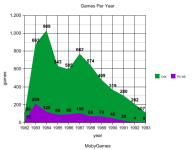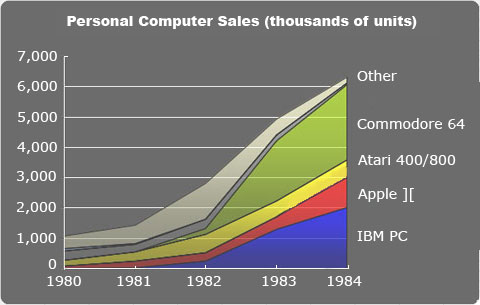Eudimorphodon
Veteran Member
You mentioned some longer timeframes for the C64 and I was wondering if you knew what they were as a percentage so we can understand the significance of those numbers with relation to the total number of games released for the C64. If you don't know the figures, a guess is fine. It will still give me more context into what you're saying.
Why are you asking me this? If you want to support your argument you can do the research yourself; MobyGames is a public database. But, sure, I'm still on break so I'll take a quick crack at it, why not.
I guess I get the case you're trying to construct here, but it falls flat on its face, sorry. Let's stick with using the Commodore 64 as the comparison; it seems fair enough, given they were both introduced at nearly the same time (late 1981 for the PC-88, vs. mid-1982 for the C64) and the hardware was produced into the 1990's. Here's an overlaid graph of the number of games produced for the systems between 1982 and 1993; Mobygames only lists a *single* title of the PC-88 from 1981 so we're not really short-changing it by leaving 1981 out.

Let's also chuck into this discussion the *total* number of games MobyGames lists for each platform:
PC-88: 556
C64: 5,598
(It's kind of spooky how close to exactly 10 times the multiple between C64 and PC-88 games is. Wow...)
The thing you seem to be harping on is the question of how many of the platform's total games were produced after 1990? Well, that's easy for the PC-88; if I leave out the *1* game produced in 2023 (which seems reasonable in this context) we have 57+20+3=80/556 = 14.4%. The C64 is tougher because its game development didn't *really* dry up until the late 1990's; to make it as fair as possible, though, I'm arbitrarily cutting it off at 1993, the year "Lemmings" was ported to it *and* the last year that the number of games per year was over 100. (This is pretty arbitrary, though, given 1994 had 87 games and 1995 had 71. If I set the threshold as proportionally low as the "3" I'm allowing for PC-88, IE, only 3% of the output of the peak year, we'd get as far as 1996 with 32 games.) 319+280+107=706/5589 = 12.6%. (If I apply the same cutoff I'm allowing for the PC-88 then we get 896/5,598 = 16%)
These numbers show your premise regarding the PC-88 as being some kind of late-surviving miracle machine is utterly false. PC-88 did not get significantly more development after 1990 than a machine very popular in the West, and in fact died both earlier and far more definitively than the C64. Like I said, the only whimper of an argument you can form when you visualize the data like this is the Commodore 64 started declining significantly from it's "peak" a few years earlier, but the flip side of this is that the C64's numbers are both much larger than and a lot more "spikey" than the PC-88's.
EDITOR'S NOTE: After running these numbers I stumbled across this page, which lists a total of 838 games for the PC-88 and has a "releases per year" chart. I'm a little leery mixing data from different sources, but, sure, If I redo my graph with these numbers it looks like this:

The amusing thing here is counting more games actually makes your case weaker... by a lot. Look how similar the profiles of the curves are now, and if we redo the math for "percentage of games released after 1990" we get 48+20+4=72/838 = 8.6%. The PC-88 is officially now worse than the C64 in terms of late relevance by a mile; the C64 had half again more games released for it after 1990, percentagewise, than the PC-88.
EDIT: I just realized this other source also has platform information for the C64, which likewise lists more games than MobyGames, but I *really* can't be bothered to update the graph again. I did eyeball the corresponding releases per year stats, however, and if you add up the totals for 1990-1993 and divide them by its total of 6316 total games the C64 scores 15.6% of its total releases after 1990, which is even better than MobyGames' numbers; the C64 had, statistically, twice as many games released in this late period than the PC-88.
Though if your answer is "because we never got porn on CP/M systems in the US" well, it's a different perspective - I'll grant you that -
You might think you made a joke here, but, no, this is *exactly* why nobody cared about CP/M. Unless you're running a dental office or accounting firm there was absolutely nothing interesting about it.
In focusing on the PC-88 you couldn't better demonstrate how much you're missing the forest through the trees: The PC-88 "put up a fight" not because it was a CP/M machine, but because it was a GAME MACHINE. First and foremost that's what it was, and I'm kind of baffled that you keep missing how unimportant CP/M was to its success. The very articles you've cited in trying to point out how CP/M "lasted longer" in Japan are very clear about how the system was kept on life support forever because it was a popular game machine, not because it could run archaic mailing list management software from the 1970's. CP/M wasn't even the primary OS of the machine; it had its own DOS that integrated with its MS BASIC, and a lot of these games you're obsessing about were self-booters.(*)
(* If we want to be nitpicky I'd argue that these Japanese computers like the PC-88 and even MSX are more like TRS-80s than they are typical CP/M machines, in that in order to be usable without disk drives their primary OS is Microsoft BASIC that they're happy to boot into from ROM. The fact that their memory maps can accommodate CP/M is almost an accidental consequence of the fact that they incorporated memory paging from the outset, largely for other reasons involving language and graphics support.)
A gaming machine needs CP/M like a fish needs a bicycle. The fact that some of these obscure Japanese gaming machines happened to have a bicycle in the garage is because they were descended from computers where it seemed like a good idea at the time, not because it made even a lick of sense for the niche they ended up falling into. The games that were the only reason people cared about these things as long as they did were not "CP/M games" and certainly weren't transferrable between systems. (You think it's hard to patch Wordstar for a different terminal, just wait until you try to run your PC-88 porno adventure on your Kaypro.) The C64 was more successful than the PC-88 despite Commodore having to, *gasp*, write their own DOS, because (in addition to being a lot cheaper) nobody in the market for a game computer gave a rat's rear about what operating system was used behind the scenes to shovel digital boobs from the floppy disk into their eye holes.
I mean, let's get real about CP/M: there's not a lot to it. Apple DOS is roughly as comprehensive as CP/M and TRS-DOS is significantly fancier than it, and both were pretty much written by one guy. (Paul Laughton and Randy Cook, respectively.) Once a computer company is selling more than a few thousand units there's a lot be said about just hiring someone in-house to maintain your OS instead of having to send royalty checks to DRI. CP/M made sense in a world where computer consultants were hired to assemble practically bespoke business computers out of a menu of individual parts while maintaining some limited pretense of interoperability and the target functionality still might involve paper teletypes, but the case for it did little but erode after that.
Last edited:




